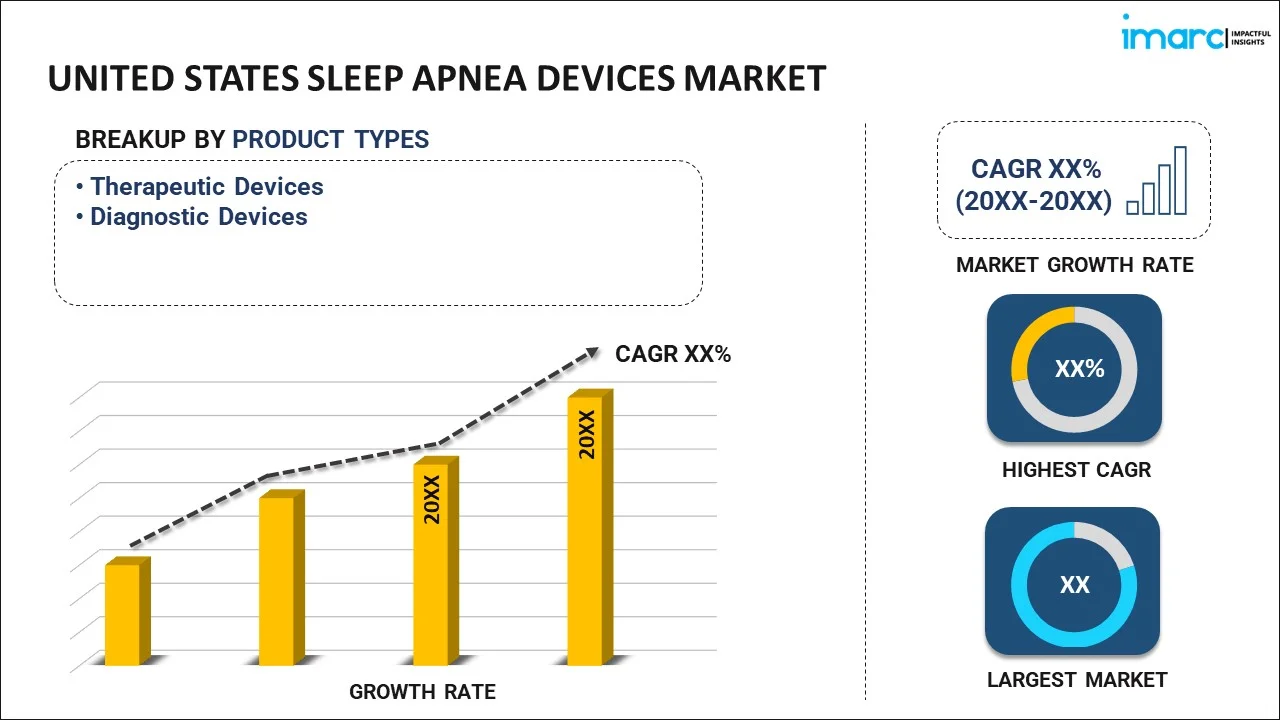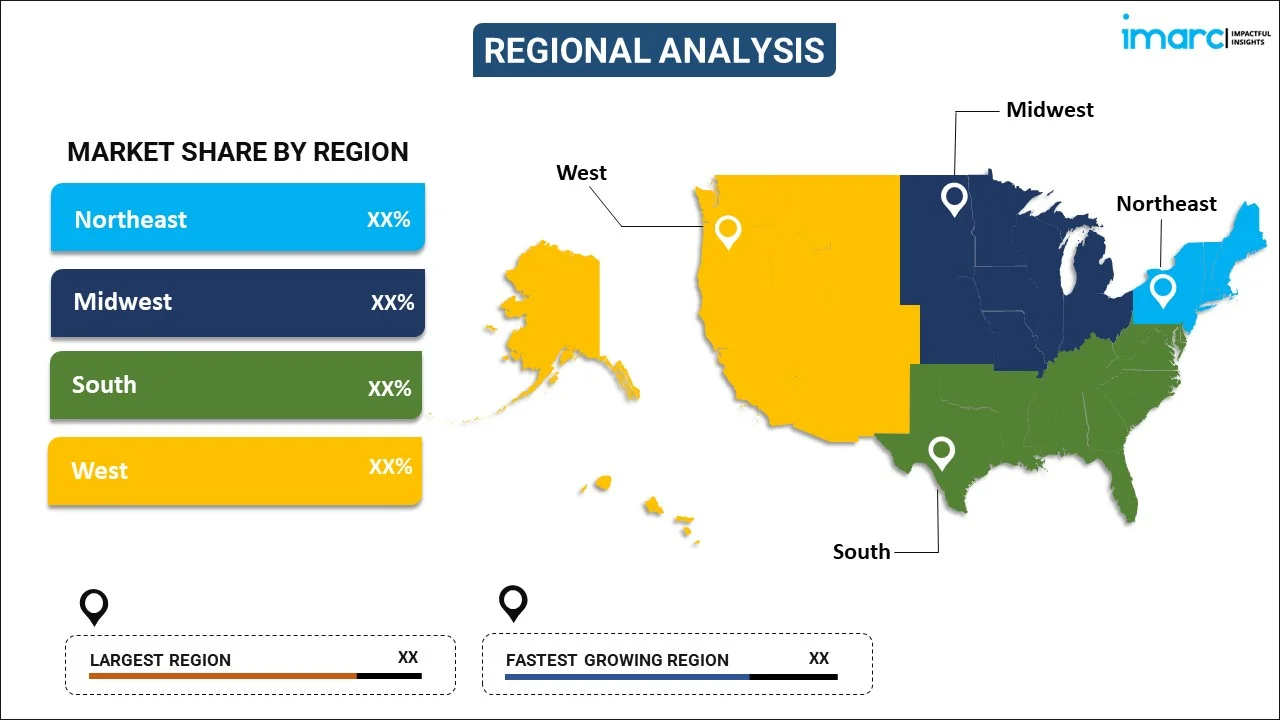
United States Sleep Apnea Devices Market Report by Product Type (Therapeutic Devices, Diagnostic Devices), End User (Hospitals and Clinics, Sleep Laboratories, Homecare Settings, and Others), and Region 2024-2032
Market Overview:
United States sleep apnea devices market size is projected to exhibit a growth rate (CAGR) of 5.60% during 2024-2032. The growing prevalence of sleep apnea among people due to higher rates of obesity and lifestyle-related health issues, rising technological advancements and increasing awareness about the importance of diagnosing and treating sleep apnea represent some of the key factors driving the market.
|
Report Attribute
|
Key Statistics
|
|---|---|
|
Base Year
|
2023 |
|
Forecast Years
|
2024-2032 |
|
Historical Years
|
2018-2023
|
| Market Growth Rate (2024-2032) | 5.60% |
Sleep apnea devices are used to alleviate the symptoms of sleep apnea, a disorder characterized by repeated interruptions of breathing during sleep. They consist of continuous positive airway pressure (CPAP) machines, bi-level positive airway pressure (BiPAP) machines, adaptive servo-ventilation (ASV) devices, and mandibular advancement devices (MADs). They are manufactured through precise engineering and adherence to stringent medical standards, utilizing materials like medical-grade plastics, electronics, and sometimes software for smart functionalities. They help alleviate the symptoms of sleep apnea, including daytime fatigue, high blood pressure, and cardiovascular risks. They significantly enhance the overall quality of life of an individual by ensuring restful sleep. They reduce snoring, improve focus and cognitive function, and decrease daytime fatigue. They are essential for individuals with moderate to severe sleep apnea, providing a non-invasive solution.
United States Sleep Apnea Devices Market Trends:
At present, the increasing prevalence of sleep apnea among people due to the higher rates of obesity and lifestyle-related health issues represents one of the key factors impelling the market growth in the United States. Additionally, rising technological advancements in sleep apnea devices with features like wireless connectivity, data analytics capabilities, and user-friendly interfaces are driving the appeal and effectiveness of these devices. The increasing investment in research and development (R&D) by manufacturers to develop smaller, quieter, and more comfortable sleep apnea devices, which improve patient compliance, is also supporting the market growth in the country. Besides this, the growing awareness about the importance of diagnosing and treating sleep apnea through campaigns by health organizations and patient advocacy groups is emphasizing the link between untreated sleep apnea and serious health conditions, such as hypertension, heart disease, and diabetes. This awareness is leading to more routine screenings and diagnoses, thereby expanding the patient base for sleep apnea devices. In addition, increasing preferences for home healthcare and remote monitoring among patients is favoring home-based sleep apnea tests (HSATs) and treatments over traditional in-lab sleep studies on account of their convenience and cost-effectiveness. This is prompting manufacturers to develop home-friendly devices, thus widening the market scope. Apart from this, the rising emergence of customization and personalization of sleep apnea devices, offering custom-fitted masks and oral appliances, is contributing to the market growth. This trend is not only improving patient compliance but is also creating opportunities for niche markets within the broader sleep apnea device sector. Furthermore, the growing integration of sleep apnea devices with consumer technology, including wearables, smartphones, and smart home devices, to enhance user experience and data management is offering a favorable market outlook in the country. This integration facilitates easier tracking of sleep patterns and device performance, enabling users and healthcare providers to make more informed decisions about treatment.
United States Sleep Apnea Devices Market Segmentation:
IMARC Group provides an analysis of the key trends in each segment of the market, along with forecasts at the country level for 2024-2032. Our report has categorized the market based on product type and end user.
Product Type Insights:

- Therapeutic Devices
- Positive Airway Pressure (PAP) Devices
- Oral Devices
- Nasal Devices
- Chin Straps
- Others
- Diagnostic Devices
- Actigraphs
- Polysomnography Devices
- Sleep Screening Devices
- Others
The report has provided a detailed breakup and analysis of the market based on the product type. This includes therapeutic devices (positive airway pressure (PAP) devices, oral devices, nasal devices, chin straps, and others) and diagnostic devices (actigraphs, polysomnography devices, sleep screening devices, and others).
End User Insights:
- Hospitals and Clinics
- Sleep Laboratories
- Homecare Settings
- Others
A detailed breakup and analysis of the market based on the end user have also been provided in the report. This includes hospitals and clinics, sleep laboratories, homecare settings, and others.
Regional Insights:

- Northeast
- Midwest
- South
- West
The report has also provided a comprehensive analysis of all the major regional markets, which include Northeast, Midwest, South, and West.
Competitive Landscape:
The market research report has also provided a comprehensive analysis of the competitive landscape in the market. Competitive analysis such as market structure, key player positioning, top winning strategies, competitive dashboard, and company evaluation quadrant has been covered in the report. Also, detailed profiles of all major companies have been provided.
United States Sleep Apnea Devices Market Report Coverage:
| Report Features | Details |
|---|---|
| Base Year of the Analysis | 2023 |
| Historical Period | 2018-2023 |
| Forecast Period | 2024-2032 |
| Units | US$ Million |
| Scope of the Report | Exploration of Historical Trends and Market Outlook, Industry Catalysts and Challenges, Segment-Wise Historical and Future Market Assessment:
|
| Product Types Covered |
|
| End Users Covered | Hospitals and Clinics, Sleep Laboratories, Homecare Settings, Others |
| Regions Covered | Northeast, Midwest, South, West |
| Customization Scope | 10% Free Customization |
| Report Price and Purchase Option | Single User License: US$ 3699 Five User License: US$ 4699 Corporate License: US$ 5699 |
| Post-Sale Analyst Support | 10-12 Weeks |
| Delivery Format | PDF and Excel through Email (We can also provide the editable version of the report in PPT/Word format on special request) |
Key Questions Answered in This Report:
- How has the United States sleep apnea devices market performed so far and how will it perform in the coming years?
- What has been the impact of COVID-19 on the United States sleep apnea devices market?
- What is the breakup of the United States sleep apnea devices market on the basis of product type?
- What is the breakup of the United States sleep apnea devices market on the basis of end user?
- What are the various stages in the value chain of the United States sleep apnea devices market?
- What are the key driving factors and challenges in the United States sleep apnea devices?
- What is the structure of the United States sleep apnea devices market and who are the key players?
- What is the degree of competition in the United States sleep apnea devices market?
Key Benefits for Stakeholders:
- IMARC’s industry report offers a comprehensive quantitative analysis of various market segments, historical and current market trends, market forecasts, and dynamics of the United States sleep apnea devices market from 2018-2032.
- The research report provides the latest information on the market drivers, challenges, and opportunities in the United States sleep apnea devices market.
- Porter's five forces analysis assist stakeholders in assessing the impact of new entrants, competitive rivalry, supplier power, buyer power, and the threat of substitution. It helps stakeholders to analyze the level of competition within the United States sleep apnea devices industry and its attractiveness.
- Competitive landscape allows stakeholders to understand their competitive environment and provides an insight into the current positions of key players in the market.
Need more help?
- Speak to our experienced analysts for insights on the current market scenarios.
- Include additional segments and countries to customize the report as per your requirement.
- Gain an unparalleled competitive advantage in your domain by understanding how to utilize the report and positively impacting your operations and revenue.
- For further assistance, please connect with our analysts.
 Inquire Before Buying
Inquire Before Buying
 Speak to an Analyst
Speak to an Analyst
 Request Brochure
Request Brochure
 Request Customization
Request Customization




.webp)




.webp)












